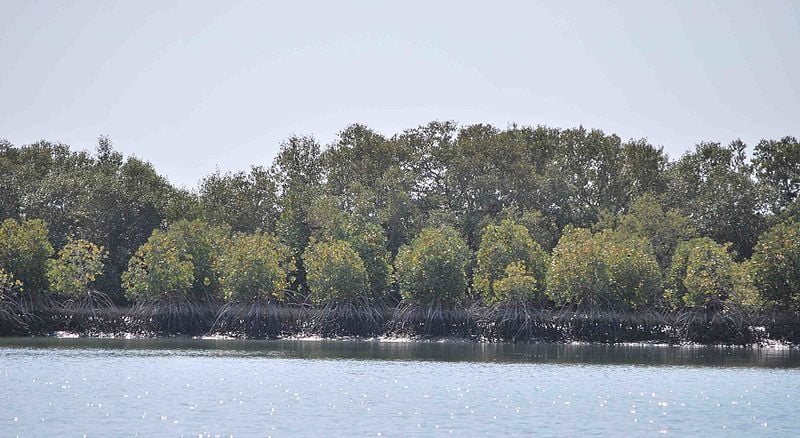Climate change, which is described as long-term shifts in Earth’s normal patterns of weather and temperature, has now become a pressing global issue. Everyday factors like the generation of electricity, transportation, manufacturing, and consumption of goods are labeled as emitters of greenhouse gases (mostly carbon dioxide or CO2), which are the sole drivers of climate change and global warming.
According to the United Nations (UNO), climate change is occurring at a much faster rate today than anticipated. Climate calamities have become more frequent from 2010 to 2020, when vulnerable regions experienced tenfold greater human mortality rates from hurricanes, floods, and droughts. In Pakistan alone, torrential downpours in 2022 triggered the most devastating flood, which affected about 8 million lives.
Despite producing less than 1% of the global climate footprint, Pakistan still ranks among the top countries affected by extreme climate events. Climate change has not only made human lives vulnerable in Pakistan but has also greatly affected its economy. According to the World Bank (WB), from 1992 to 2021, climate-related disasters have caused a total of US$29.3 billion in economic loss from damage to livestock, crops, and properties, equivalent to 11.1% of Pakistan’s GDP in 2020.
How Climate Change Is Affecting Pakistan’s Indus River System
One major problem that has grappled Pakistan in recent years due to the adverse impact of climate change is the depletion of water resources. Pakistan is ranked among the top water-risk countries in the world. According to the United Nations Development Programme (UNDP), Pakistan will reach absolute water scarcity by the year 2025. Climate-related threats, including receding glaciers, rising temperatures, and droughts, are putting stress on water resources in the country, especially the Indus River system in Pakistan. According to the International Water Management Institute (IWMI), the Indus is to become a seasonal river if glaciers in the north of Pakistan continue to melt by the year 2050.
Indus Basin Aquifer
The country’s groundwater recharge system, the Indus Basin Aquifer, has been ranked as an extensively stressed underground water reserve. The basin, acting as the major source of water in the country for irrigation, agriculture, and domestic needs, depends on glacial melt and snow. It particularly relies on the glaciers located in the Karakoram, Hindu Kush, and the Himalayas; however, these sources have become increasingly sensitive to climate change. According to the International Center for Integrated Mountain Development (ICIMOD), the Himalayan glaciers are expected to lose 70% of their ice by the century’s end due to global warming.
The climate crisis has also set alarming bells in Pakistan this year. The country experienced a snowless winter in its mountain valleys, receiving only one to two inches of snow, while its average snowfall from December to January was 47 inches. According to the Pakistan Meteorological Department (PMD), since 1950, the precipitation rate has increased and the snow rate has decreased in the country. A reduction has been recorded in snowfall over the past five years.
With climate change affecting the water cycle in Pakistan, it is estimated that climate change will reduce the surface water storage capacity of the Indus Basin by 30% by 2025. The Indus Basin supplies water for 90% of food production in Pakistan, accounting for 25% of the country’s gross domestic product. As a result, climate change poses a great threat to Pakistan’s agriculture sector and if the Indus Basin falls short of water, it will cause a food shortage of 70 million tons in Pakistan.
Indus River Delta
Another feature of the mighty Indus River System that has become vulnerable to climate threat is the Indus River Delta. The delta, also termed the “vertebra of Pakistan’s ecology and economy,” is a typical fan-shaped delta that forms where the Indus River flows into the Arabian Sea. It includes areas of the south of Sindh and the Kutch region of India as well. The Indus River Delta is a complex system of streams, swamps, and mangrove forests, which are the largest arid mangrove forests in the world.

However, the delta has become vulnerable to climate-induced calamities. Climate change-induced sea level rise is one cause that has resulted in the shrinkage of the Indus Delta by 92% in the last two decades and the degradation of the mangrove ecosystem by 10%. A temperature increase of 2°C was recorded in the first half of the 21st century in Sindh and an estimated increase of 3°C has been predicted in the second half of the 21st century.
The temperature rise, higher rates of precipitation, and low rates of elevation are affecting the occupants of the Indus River Delta, resulting in livelihood loss and forced climate migrations. Due to growing water scarcity in Sindh, it is estimated that sectors of fisheries, agriculture, and forestry may face a loss of 1.3 billion PKR from 2000 to 2025 due to climate change.
Around three-quarters of the rural population resides in the Indus Delta and depends on fishing as their source of income. However, the loss of freshwater in the Indus Delta has caused damage to not only the ecology but the human economy as well. Climate change is escalating the saltwater intrusion in the region. For instance, in the Thatta district in Sindh, which is located in the Indus Delta, about 0.5 million hectares of fertile land is affected by seawater intrusion.
Climate Mitigation Efforts by Pakistani Authorities
Pakistan is a party state to the Paris Climate Accords adopted in 2015. The country has aimed to support global efforts to mitigate climate change. Under this agreement, Pakistan has set a target to reduce 50% of its greenhouse gas emissions by the year 2030. To achieve this target, Pakistan has aimed to shift to 60% renewable energy and 30% electric vehicles by 2030. It also plans to ban coal imports and expand nature-based solutions. The need of the hour is to formulate effective policies to prevent an increased scarcity of water resources.
The Pakistan Council of Water Resources (PCRWR) predicts that the country will run out of water by 2025 if immediate actions are not taken. A major development in this regard should be to establish a framework to conserve and manage water resources, which are greatly challenged by climate change. The blueprint to achieve a sustainable environment—the UN Sustainable Development Goals (SDG)—calls for all nations to develop a sustainable system of water management.
Pakistan also aims to increase its water storage capacity to ensure water conservation, in line with the SDGs under its vision for 2025. Institutions like the Pakistan Climate Change Council, the Pakistan Climate Change Authority, and the Climate Change Funds have been established to implement policies and fulfill commitments to mitigate climate crises.
Moreover, Pakistan’s National Water Policy of 2018, aims to delineate climate-related threats with the development of “drought-prone planning zones” and “flood risk management and regulatory zones.” The measures taken under the National Water Policy are also in line with the stipulations of the Pakistan National Climate Policy to mitigate rising concerns related to the water sector.
To control the issue of water insecurity in the country, provinces like Punjab and Khyber Pakhtunkhwa have also introduced their own water policies. Punjab introduced its Punjab Water Policy in 2018 and Punjab Water Act in 2019, which provide comprehensive guidance on the conservation and management of water, especially during climatic challenges like droughts. Similarly, Khyber Pakhtunkhwa introduced the KP Water Act in 2020, which aims to ensure the sustainability and conservation of water resources in the province.
Successful Mangrove Ecosystem Restoration in the Indus Delta
Although Pakistan has taken several initiatives to mitigate the adverse impacts of climate change, their effective implementation and on-ground impact on the environment and civil communities have yet to be observed. The implementation mechanism of these initiatives and policies depends on the federal government, which lacks adequate resources in this regard.
Sometimes inadequate budget allocation impedes the financing of these climate initiatives and sometimes political propaganda hinders the smooth or long-term implementation of these crucial climate endeavors. However, there are instances where governments have successfully initiated ecosystem regeneration programs as part of climate change solutions.
The ecosystem regeneration program in the Indus Delta to revive mangrove covers is one such initiative. Through joint efforts led by the Sindh Forest Department, local communities, the International Union for Conservation of Nature (IUCN) Pakistan, and the World Wildlife Fund (WWF) Pakistan, mangrove covers in the Indus Delta have increased from 86,000 hectares to 130,000 hectares from 2005 to 2021.

With the rehabilitation of mangrove covers, fish stocks have also been revived, enhancing communities’ livelihoods in the Indus Delta. The initiative aims to restore the lost glory of the Indus Delta and plays a significant role in adapting to climate change. Another initiative is the Delta Blue Carbon Project, a public-private partnership project aiming to restore degraded mangrove covers in the Indus Delta. The project has restored about 73,000 hectares of mangrove cover to meet the climate ambitions of Pakistan, as mangroves are carbon sinks. The project further aims to restore 350,000 hectares of mangrove cover, eliminating about 140 million tonnes of carbon dioxide (CO2) emissions.
Way Forward
Along with domestic initiatives, Pakistan must foster regional cooperation with neighboring countries for transboundary water management in the Indus River Basin to ensure sustainability. However, the Indus Waters Treaty that governs water relations between Pakistan and India does not address the issue of climate crisis challenging the basin. There is a need to focus on bilateral water cooperation between Pakistan and India, as Article VII of the Indus Treaty emphasizes future cooperation.
Such a step can be taken by enhancing the role of the Permanent Indus Water Commission to resolve issues like water management and address the effects of climate change. The authorities must invest in increasing water storage capacity and efficient surface water management to ensure sustainability in the Indus. In a country where water scarcity has increased by more than 70% in the last seven decades, it is critical to recognize that this crisis is not only a consequence of climate change but an emerging social and economic concern as well.
If you want to submit your articles and/or research papers, please check the Submissions page.
The views and opinions expressed in this article/paper are the author’s own and do not necessarily reflect the editorial position of Paradigm Shift.
Khizra Rashad is currently pursuing her bachelor’s degree in international relations from Kinnaird College for Women and University, Lahore. She has a profound interest in writing on diverse domains, including global history, international law, and regional geopolitics.



